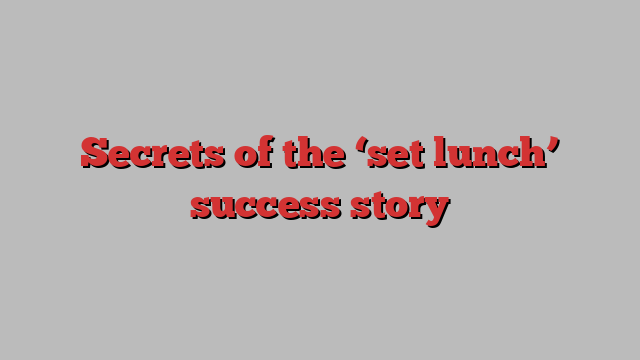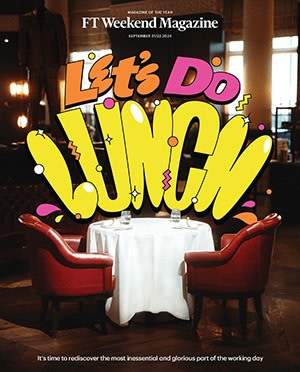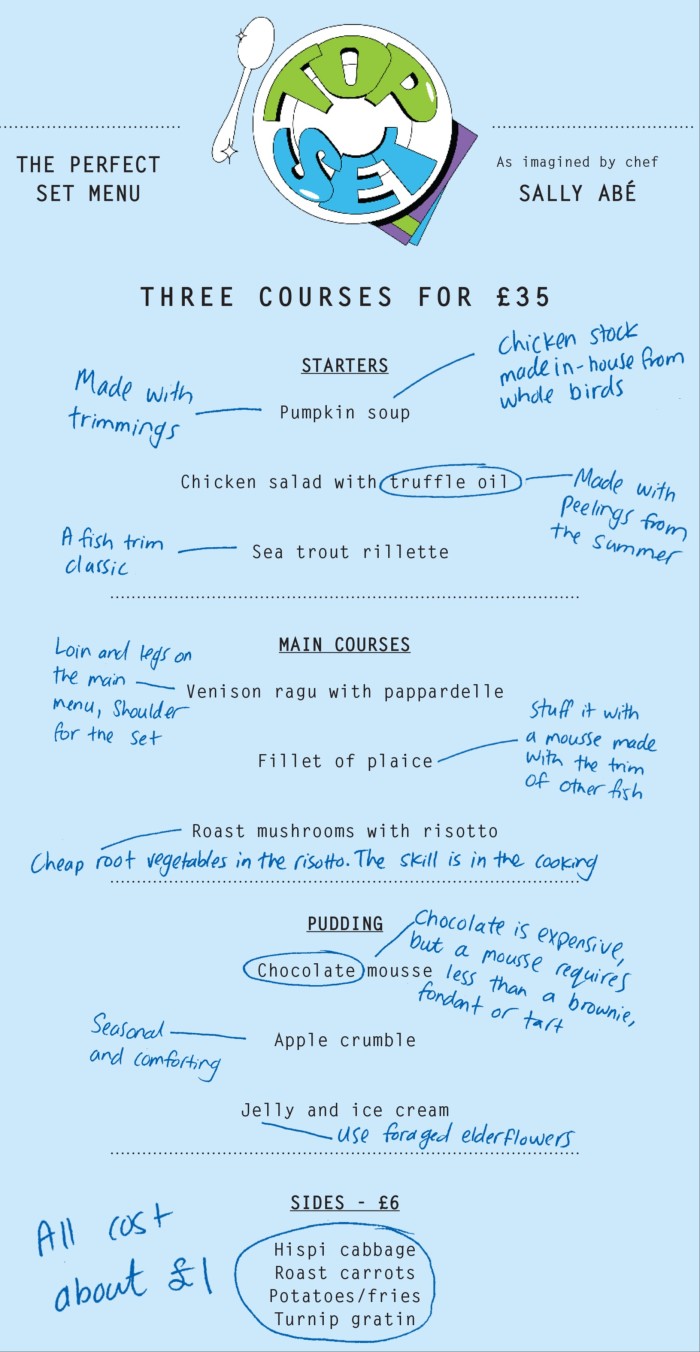
It is a warm Friday lunchtime on the South Bank in London, and Lasdun, a romantic, white-tableclothed restaurant, is alive with activity. Which is odd, because it sits inside the heavy, brutalist National Theatre, not known for attracting much of a crowd for anything other than a speedy pre-show dinner. The diners have descended because, at the tail-end of each week, the restaurant puts on an enticing set menu: steak, “hand-cut” chips and salad for £20. Visit any other time and the same figure would barely cover a starter.
It’s a similar story at Henri in Covent Garden, chef Jackson Boxer’s Paris-inspired bistro, where the most expensive small plate costs £23 but £28 will get you three courses including saucisse de Toulouse and 24-month Comté. Or you could eat bavette and Béarnaise at Noble Rot (three courses, £29), pig’s ear ragu at Dinner by Heston (three courses, £65, whereas the evening tasting menu is £160) or the Teja lunch menu at BiBi (three courses plus snacks for £45).
London is not the only place in the grips of set-lunch madness. The same is true in restaurants from Bristol to Manchester, Cardiff to Edinburgh. As spiralling food costs and rents have pushed à la carte prices higher and higher, affordable set menus have not just clung on but become more popular. This has created a situation where, in 2024, eating at the finest restaurants in the land might cost much the same as lunch at Nando’s or PizzaExpress, both of which invite bills upwards of £20 per head. Hardly inspiring when the same sum will afford lunch at the liveliest new opening in town. So how on earth do restaurants do it, and why?

In my decade-plus covering food and drink, pricing has never really led the narrative. Even the most garrulous chef clams up when costs are concerned, preferring to focus on methods, ingredients and sustainability. But as I worked through my contacts list, I discovered that chefs and restaurateurs were surprisingly willing to talk about set menus, because putting together a clever one was a point of pride.
Sally Abé, head chef at The Pem in Westminster, told me that the best set menus appear simple but are extremely complex by design. Like almost all top restaurants (and unlike, say, a high-street chain), Abé buys in whole animals rather than pre-portioned cuts and costs the animals solely against the à la carte menu, where starters begin at £16 and main courses £31. So a cod destined to be served as fillets on the main menu might cost £12, but the less desirable-looking trim of the fish — its belly, cheeks, and bones for stock — are essentially free.
“If we have cod on the à la carte, I might do a salt cod brandade on the set menu,” she explained. “I’ll use the belly and maybe serve it in a panzanella salad, another dish that uses ‘waste’ ingredients — yesterday’s bread with beautifully ripe tomatoes. It could be the same with guinea fowl: the breasts are on the à la carte; I’ll confit the legs and serve them with braised beans for lunch.”
Other chefs told me the same, including James Thomson, co-founder of Wild Flor in Brighton, where two courses from the set menu cost £22 — less than almost all of the main dishes. He sometimes buys in halibut for the main menu, and turns the trim into a fish curry. “There’s so much good meat left over.”
The more image-conscious the diners, the more chefs have to consider their strategy. At the recently reopened west London celebrity hang-out Julie’s, soon to launch a set lunch menu, it’s particularly important to be circumspect with “lesser” ingredients. Chef Owen Kenworthy’s seafood risotto might garner its “luscious collagen” from less-than-sexy skate wings, but a scattering of plump mussels is a visual necessity.
Portion sizing is another piece of classic tradecraft, said Josh Eggleton, who runs a successful group of restaurants in the south-west, including his flagship the Pony Chew Valley (starters from £10, mains around £30). Lunchtimes, notably during the week, allow for smaller dishes because people aren’t going all out. A fish portion on the main menu would be cut to between 180g and 190g, whereas on the set lunch menu it would be closer to 110g. “Customers are getting a starter, main and dessert for a low price point but they still leave satisfied.”
At Sonny Stores in Bristol, where mains sit between £18 and £32, head chef Pegs Quinn puts on a three-course set lunch during the week for £25 and works to a similar rhythm. “We try to hit that magic 70 per cent gross profit,” he said. (This is generally the baseline when looking to make a restaurant profitable, as so much is eaten up by other expenses.) “To make £25 work financially, we do the same dishes [as the à la carte] as smaller portions — about two-thirds of the size.”
Matt Paice, co-founder of the Michelin-starred west African restaurant Chishuru, points out that most restaurants deploy a combination of these tactics. Its £45 three-course lunch has smaller portion sizes and is generally streamlined. “We save the premium proteins for dinner, where there might also be more elements to dishes; they might be more complicated,” he said. “The lunch menu is a simpler offering.”

Any restaurateur will tell you that their job is as much about psychology as it is about mathematics. Sometimes, that means taking a bit of a gamble: at The Dining Room in Abersoch, north Wales, chef-owner Si Toft says he has to have steak on the menu “because people always look for it” but just hopes that more people will opt for the inexpensive pig’s cheek, which has far better margins. And upselling is a key skill. A lot of chefs I speak to mention snacks and sides, priced separately to the set menu, as the best way to get customers to spend more than they planned to. At Gary Usher’s group of restaurants in the north-west, a lunchtime or pre-theatre deal might be as low as £15, but will include the option to add bread for £5, and sides of chips, carrots and long-stem broccoli for the same price. “The hook is £15, it gets people in, but our front of house will offer a glass of prosecco (£7.50), a side of chips (£5), long-stem broccoli (£5),” he said. “Suddenly, £15 becomes £25 and we’re making a little bit of money. But the food is still fantastic value and customers are always happy.”
Back at Wild Flor in Brighton, Thomson goes further, offering guests a set £20 drinks pairing, something of a rarity in the realms of set lunches: “A glass of fizz with home-made cordial, from berries from our allotment, a glass of decent wine, and a small measure of a sweet wine with dessert.”
Spending £20 on drinks is more than most people would consider at lunchtime, but diners are drawn to it because they’ve saved on food and so are inclined to be indulgent elsewhere: the mechanics of the discount lunch encourages a degree of frivolity.
As I worked my way down the list of restaurants, I realised that although set menus are formulaic exercises — the jigsaw puzzles of the kitchen — they’re also about the bigger picture. Each chef I spoke to told me that set menus help bring in a younger, more diverse crowd.
“I do want to try and be accessible where possible, to broaden the net,” said Mark Birchall, the founder of two-Michelin-star Moor Hall in Lancashire. At his one-star sister restaurant, Barn, three-courses are £42, well below the à la carte, where single dishes climb to £62. “I think we’re respectfully priced considering the skill and the ingredients . . . but we’re still taking a bit of a punt.”
And then there’s the buzzy uplift that a restaurant gets from regularly being full.
There is no better argument for the proficiency of the set lunch than the fact one of the most successful restaurant launches of the past year is running one, above The Devonshire pub in Soho.
Co-founder Oisín Rogers has been in hospitality long enough to know that, however popular a venue is, the hype train moves on eventually. Set menus are a way to keep a crowd. They encourage repeat customers rather than the “venue hopping” that Londoners are used to. Three courses for £29 at one of the coolest joints in town? Hard to beat — even Guy Ritchie is a fan.
“We have to make a small amount of margin on it, but beyond that the idea is to fill seats and to make sure people feel well looked after,” says Rogers.
“Maybe they’ll have a pint of Guinness or two, talk about the pub, tell their friends and colleagues to come. We don’t complicate anything. It’s a prawn cocktail, steak and chips with Béarnaise, and sticky toffee pudding. Most people love them and we’re able to charge less for them than the premium things.”
Follow @FTMag to find out about our latest stories first and subscribe to our podcast Life and Art wherever you listen